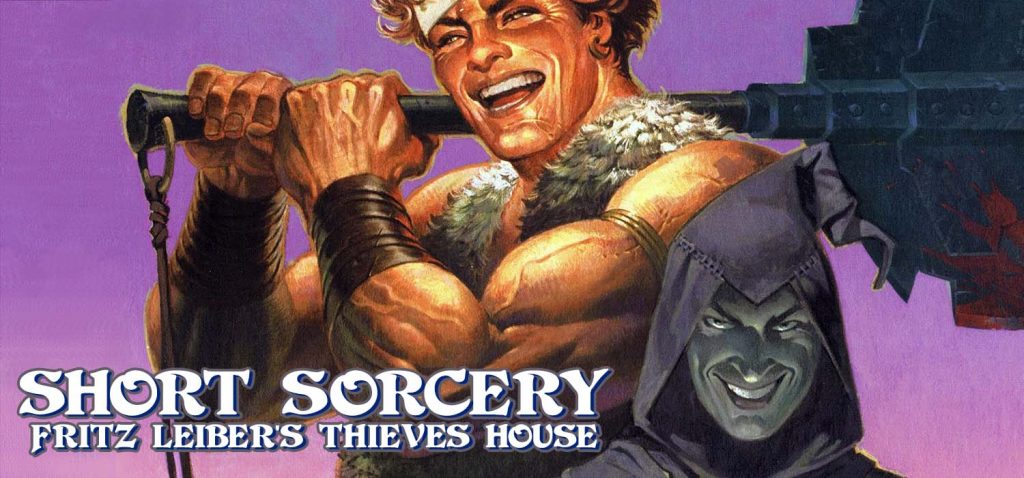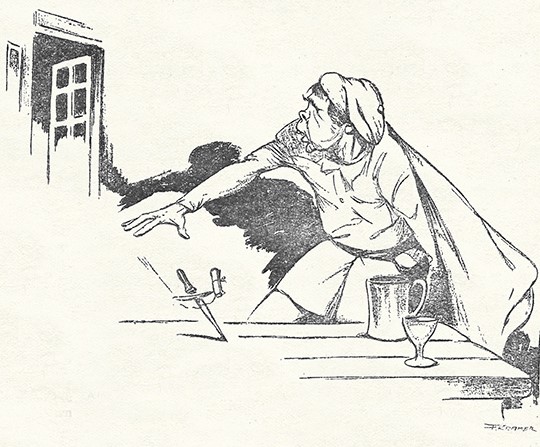Short Sorcery: Fritz Leiber’s “Thieves’ House”
by Bill Ward
More than any other classic sword-and-sorcery series, Fritz Leiber’s Lankhmar tales of Fafhrd and the Gray Mouser are associated with thievery. It isn’t just that the twain, the dynamic duo of tall Northerner Fafhrd and shifty little Mouser, are themselves consummate rogues of wild daring and tremendous fame, but that the world they usually inhabit, the crazy mazey streets of Lankhmar, is thickly populated by cutpurses, sneaks, assassins, bravos, backstabbers, pickpockets, skullduggers, and rapacious robbers of all stripes. Indeed, a great amount of the DNA of thievery in fantasy fiction, particularly after the advent of Dungeons & Dragons, can be traced to Leiber’s Lankhmar. The City of Sevenscore Thousand Smokes could just as well be called the Town of Twice Ten Thousand and Two Thieves.
In “Thieves House,” Fafhrd and the Gray Mouser come into direct conflict with Lankhmar’s Thieves Guild, after being hired as freelancers to recover an ancient jeweled skull (and matching skeletal hands, fingernailed with rubies) from a highly guarded temple crypt. It is the Skull of Ohmphal, once a great Master Thief, his remains long ago stolen from the Guild and forgotten until a chance discovery revealed their whereabouts. Not only was this particular Skull forgotten, but the very notion of respecting the bones of a departed rogue has become an alien concept among the guild: “I never heard tale of a Thieves’ Sepulcher, save the junkyard, the incinerator, and the Inner Sea.” says fat Fissif, the slippery backbiter who hires the twain for the Skull heist with the full intention of double-crossing them. Krovas, Master of the Guild, replies simply; “Times and customs change … periods of reverence alternate with periods of realism.”
First appearing in the pages of Unknown (Worlds) Magazine in 1943 – the fifth and last Fafhrd and the Gray Mouser tale to do so before the magazine folded – “Thieves House” belongs to the earliest run of Lankhmar stories, those that would come to be collected in Swords Against Death (originally titled Two Sought Adventure).* These tales are Leiber at his pulpiest and most fast-paced, his gifts for wordplay and inventive asides evident but kept in check by the need for forward momentum. One of the oddities of coming to the Lankhmar saga through its collected works is the high variation in style between stories that might come one after another in the chronology of the twain, a perfect example of which would be the 1970 novelette “Ill-Met in Lankhmar” essentially serving as a prequel to “Thieves House,” a story written nearly 30 years prior. The version of “Thieves House” found in Swords Against Death contains a few alterations and additions to reflect the more recently penned origin story, though none of these are major alterations (perhaps the biggest difference would be the implied life-long familiarity of the Gray Mouser with the thieves of Lankhmar, something contradicted by Leiber’s later filling in of the blanks in his background). Though the notion that the Guild would want anything to do with Fafhrd and the Gray Mouser after the events of “Ill-Met” – anything other than skinning them alive that is – feels like a bit of a stretch.
But absolutely none of that matters in terms of the story itself, for “Thieves House” is one of those classic, rollicking, kick-down-the-doors-and-charge-hell-for-leather yarns that manages to encapsulate a big story in a small space in a way that demonstrates the true strength of short fiction. Leiber leaps forward from scene to scene almost like acts in a play, leaving out the uninteresting or unimportant bits and creating a tight through-line of plot and intention. After the brief opener establishing the premise, we are immediately racing headlong into the Thieves Guild HQ itself, ducking nooses and avoiding assassin’s blades emerging from secret doors almost before we catch our bearings. The twain have pulled off the Skull heist and been ripped off by Fissif between the scenes, and Fafhrd and his “angry little weasel” are coming in hard and fast. They discover Krovas, the Guild Master, strangled dead, and a beautiful redhead fleeing the scene with the object of their search, the Skull of Ohmphal. Is she a murderess, or has something yet darker transpired as Krovas sought to separate precious jewel from yellowed bone?
The twain’s pursuit of her and the Skull is stymied by yet another secret passage and, whatever surprise initially afforded them by their daring frontal assault on the guild now completely evaporated, Fafhrd and the Gray Mouser must flee through the labyrinthine corridors of the Thieves House to escape with their lives. The titular Thieves House itself is something of a mirror of larger Lankhmar – chaotic and deadly, and harboring dark, unguessed secrets. Fafhrd, banging his head one too many times on lintel and doorway as he races through the gloom, soon stumbles upon one of these secrets when he is separated from his diminutive companion while wandering in a disoriented daze.
“In the trackless dust of centuries strange things may lurk.” The action story now becomes horror as Fafhrd, blundering near-senseless into an unlit, forgotten cellar of the Guild, encounters Ohmphal’s fellow restless dead. They surround him in the pitch dark, disembodied voices and barely-glimpsed glints of color from the jewels in their eyes, and lay a charge upon Fafhrd – whom they recognize as one of the three that stole Ohmphal from the temple – to return their lost brother before midnight next. It’s a chilling scene, well constructed for maximum effect, and with the memorable detail of Fafhrd snatching a flying thing from the darkness and discovering himself clutching a bat’s skeleton. Perhaps other pulp heroes would find such goings-on mildly disconcerting, but Leiber allows his hero the human vulnerability of real fear in the face of the inexplicably sinister, and Fafhrd, reduced to a kind of animal terror, “shook and started like a frightened horse” and ran back the way he came.
Whereupon he is promptly smashed in the crown by Fissif, and captured. The freshly escaped Mouser, at his rendezvous in the Silver Eel, receives a message from the guild echoing the same words as the ancient thieves of Lankhmar – return the Skull to us by midnight next, or your companion suffers the consequences. Of course, Mouser has to find the Skull first.
In moving the action forward to the next evening, Leiber not only maintains pacing and efficiency, he also allows fresh opportunities to misdirect and tantalize the reader. This is done in the person of a hobbling old woman feebly making her way through the dense city fog. She is kindly assisted by one gentlemen, rudely jostled by the next. Curiously, the rude young man that thought nothing of blundering into his frail elder immediately receives a karmic boot up the backside, seemingly out of nowhere – later that night, still reeling with superstitious confusion, he goes home to share half his wages with his old mother. There is nothing quite like the inexplicable to banish realism, and instill reverence.
Of course, we have guessed that the tottering old crone is Gray Mouser is disguise, a disguise he uses to gain entrance to the abode of Ivlis, the former doxy of the former Krovas, the beautiful redhaired woman that had escaped the guild via secret passage the night before, Skull in tow. Mouser’s performance is near-flawless, his natural talents toward deception and dissembling given full flower in his brilliance as an actor – an act he nearly loses himself in, so engrossed is he by his own powerful imagination. Concurrently, at Thieves House, Fafhrd is voicing his own natural talents as a storyteller, relaying to the assembled and increasingly terrified guild an amplified campfire-spook-tale version of his encounter with the dead that lurk in their very cellars. Character flourishes like this are one of the things that make these stories, and the dynamic between these two characters, eminently rewarding. The twain aren’t just amazing swordsmen and daring rogues, they possess powers of intellect and personality that make them a thousand varieties of formidable, and endlessly entertaining to boot.
Mouser’s mummery continues as he goes from playing witch-woman to revenant of undeath, emerging from the secret passage into the Thieves House with the newly recovered Skull of Ohmphal wielded as a prop, Ivlis and her bodyguard hot on his heels. The grand finale devolves into a chaotic melee until the new Guild Master asserts a materialist conception of reality by smashing the jeweled skull into flinders. His philosophical point is immediately refuted by the approach of midnight and the killing vengeance of the ancient dishonored dead of the guild. Two Guild Masters dead in as many nights has a profound effect. While our heroes slink off to enjoy the rewards of freedom, fine drink, and a fetching companion in Ivlis, Leiber informs us that in the coming days the thieves of Lankhmar became most pious in honoring their unquiet dead, even tithing unto them a third of all they stole. Like the rude young man receiving an inexplicable kick in the shorts, the thieves guild has been taught the kind of lesson that only a brush with the ineffable can instill. And it is just as Krovas said: “Times and customs change … periods of reverence alternate with periods of realism.”
*Not to be confused with “Two Sought Adventure,” the original name of “The Jewels in the Forest,” the first published Fafhrd and the Gray Mouser story, which is of course also included in this collection, and probably had its name changed in order to use it for the collection itself … which (of course) then went on to have its own name changed to Swords Against Death when the series was updated and collated and all the books branded with a more cohesive naming convention.
The three illustrations accompanying the body of this essay are Frank Kramer’s original art from the first publication of “Thieves’ House” in the February 1943 issue of Unknown Magazine. The header artwork is by Jim Steranko.










